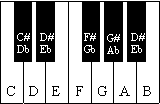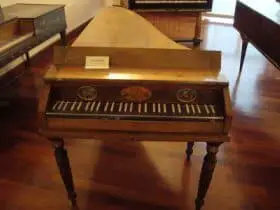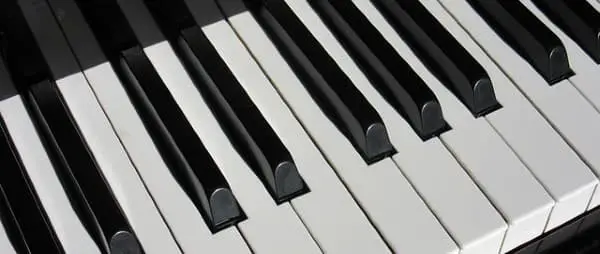- Home
- Adult Beginner Piano Lessons
- Piano Keyboard Layout
Piano Keyboard Layout: Finding Your Way Around the Keys
This article may contain compensated links. Please read the disclosure for more info.
Why the piano keyboard layout arranged the way it is? How do you find all the notes? Let's look at the piano keyboards design, and how it has changed to fit our needs over time.
The Piano Keyboard Layout
The keyboard may have many keys, but there are only 12 different keys;
- 7 white keys (starting and ending on a C, the white keys create the C major scale).
- 5 black keys (they form a pentatonic scale. The black keys make it possible to play in many different tonalities as well).
- That's in total only 12 different keys.

The keys are arranged so that you can see groups of 2 and 3 black keys easily. This grouping makes it easier to locate the notes on the piano keyboard.
As you can see here, the note C is positioned to the left of the two black keys:

Tips: Keyboard stickers are a handy tool to learn the note names on the keys.
If you know where C is, you can figure out the rest of the piano notes!
The same pattern of notes is repeated with a higher (to the right) and lower (to the left) pitch all over the keyboard.
How many keys are there?
Most acoustic pianos today have 88 keys, but there are keyboards with fewer. Click here for great deals on piano keyboards.
But Why is the Piano Keyboard Layout the Way it is?
One of the questions I often get as a teacher is why the keys on the piano are arranged the way they are.
Actually, throughout time, piano keyboards have gone through many transformations, and there have been many variations of the piano keyboard layout.
All the way from the ancient Hydraulis to the modern instrument of today, the piano keyboard setup and design has changed after the scales used, what kind of materials were available, the tuning of the time, as well as different ideas on how to best play those notes.
Pattern of Black & White Keys
 Layout Piano Keys: Piano keyboard layout of an 18th Century Fortepiano.
Layout Piano Keys: Piano keyboard layout of an 18th Century Fortepiano.The pattern of the black and white keys has also changed.
At times the piano layout of the keys was inverted. Instead of the five black keys, they were white and the other way around.
The white keys were traditionally made from Ivory (Yes- elephant tusks 😞) and Ebenholtz or Ebony, a strong type of black wood.
Today the keys are made from synthetic man-made materials and wood.
Scales and Intervals on the Keyboard

The black keys also form a pentatonic scale! (That's why it sounds so good to only play the black keys on the piano!)
The scale on the white keys, from C to C, is the diatonic 7 note scale, also called the C-major scale or Ionian mode. And from A to A, there is an A-minor scale (natural minor) or Aeolian mode.
You can from each white key ascending (going up), play one of the 7 scale modes with only white keys. And using the chromatic changes with the black keys, you can change each scale (as well as create others) and transpose (move) the scale patterns to start from any note.
Pretty clever, huh?
However, there are two important compromises. One is you can not play musical intervals smaller than a half step. The other is that the modern piano is tuned in a well-tempered tuning- resulting in that the notes in between them are all a tiny bit false.
This small falseness is hardly noticeable for a modern ear but makes it possible to smoothly play in many tonalities.
So, How Many Keys are There on a Piano?
The number of keys is different from instrument to instrument. Most pianos since 1870 have had 88 keys. But there exist older grand pianos with even a few more, some with less, and of course an electronic piano keyboard can have much fewer keys.
The size of the keys themselves have also varied. So, the keyboard layout of the piano has gone through many changes throughout history and still continues to evolve today.





